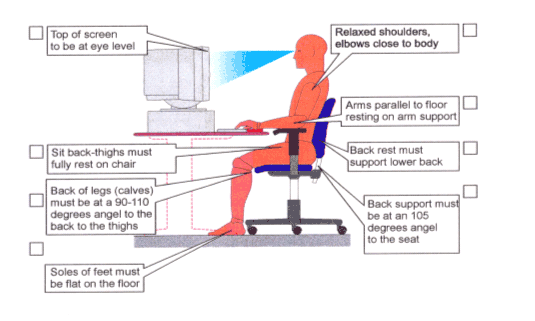General Safety
Ergonomics
Office ergonomics video
Ergonomics for Lab Workers
What is Ergonomics?
Ergonomics is a science that deals with evaluating and improving the interface between man and his work environment by adapting the working conditions, equipment and tasks to the natural functioning of the person to his physiological and mental capacity in order to improve the user's comfort, health and efficiency of work.
Frequently, due to the ability of our body to adjust, we tend to fit ourselves to the workstation rather than adjust the work station to us. This might lead to accumulating physical trauma that eventually will damage musculoskeletal system in various parts of the human body.
Risk Factors
- Inadequate working position
- Mechanical pressure
- Repetitive movements
- Immobility
- Light
- Noise
Prolonged exposure to these risk factors can result in cumulative bodily injuries
Sitting in front of the Computer
- Adjust the height of the chair according to the height of the work station, ensuring that your hands are at ninety degrees angle, between arm and forearm, parallel to the table, your shoulders are relaxed and without strain.
- Should your legs not reach the floor, add a footrest..
- Lean back on the chair in a 105 degrees angle. This will reduce pressure on your back. (Use the chair lever to change the angle of the back rest)
- Adjust the height of the back rest of your chair for full support of the lower back.
- Adjust the height of the computer screen until its upper edge is on the same height as your eyes. If the screen is low, its height should be adjusted. Another option is to raise the screen.
- The optimal distance between your eyes and the screen should be that of the extended arm, i.e., between 60 to 70 cm.
- The keyboard and the mouse should be placed side by side, 8 – 10 cm. away from the edge of the table, to Allow palms to be placed directly with the mouse and keyboard. .
- While typing make sure that your wrist is positioned straightly and that your wrist is not bending.
- The forearm should be supported by the table or by the arms of the chair.
- It is recommended to take breaks, five minutes every hour, and perform stretch and relax exercises.

Avoiding movements that can traumatize the body
- Avoid bending forward for an extended period of time. This might weaken the ligaments in the lower back and consequently cause lower back aches.
- Avoid extending your arm for too long. This will cause pressure on the arms, shoulders and neck. Make sure the most frequently used accessories are within reaching range, ideally up to 40 cm from your body.
- Avoid bending or stretching your neck too much or for an extended period of time, i.e., over 15 degrees upwards or downwards. This might cause pressure on the neck and back. It is recommended that you raise or lower the screen, according to the ergonomic rules.
- Avoid blocking the space around your legs with various objects. This might cause an improper sitting position. Sit in a free leg position forward and free space to add footrest
- Avoid bending your wrists while typing. Sit properly and position a supporting pad under your wrist.
- keep your elbows tight to the body.
Ergonomics in the Laboratory
Sitting and Standing
- While working in front of a high work surface it is recommended to work standing and sitting alternately
- While sitting, the height of the back rest of chair should be adjusted to the height of the work surface, elbows parallel to work surface.
- It is advisable to attach the backrest of the chair to the lower back.
- Use a proper laboratory chair with a ring that supports your feet.
- Frequently used tools and accessories should be placed up to 40 cm from your body.
- Rarely used tools and accessories should be placed 40 – 60 cm. from your body.
- When standing for a long time, reach out a leg forward by stepping Change this position alternately.
Lifting and carrying
- Use the stool to reach objects and bottles that are placed high up
- When lifting heavy objects, bend your legs in a step and keep your back straight while lifting.
- When moving an object, carry it close to the body and if it is necessary use a cart.
Working with pipetors
- When using pipetor lift your arm parallel to your body.
- It is advisable not to exert prolonged pressure which might cause extensive pressure on the thumb.
- Pipetors should be placed within reasonable range for comfortable accessibility between 40 – 60 cm.
- When using micropipetors (small volumes), it is reccomended to lift the Eppendorf test tube instead of bending the head forward.
- Make sure there is normal light intensity. This will improve the quality of performance.
- It is recommended to take breaks, five minutes every hour, and perform stretch and relax exercises to your wrist.

